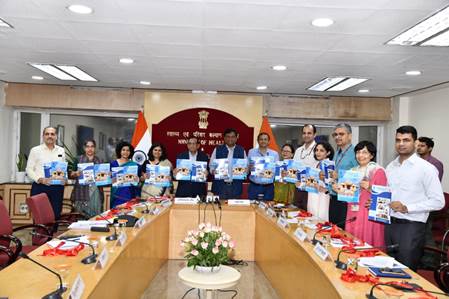Context:
Recently, India’s total health expenditure per capita has increased, while total health expenditure as a share of GDP has roughly remained the same from 2013-14 to 2021-22, according to the NHA Estimates.
Key Findings:
Per Capita Health Expenditure:
- The total health expenditure considers current and capital expenditures incurred by government and private sources. It was estimated to be Rs 9,04,461 crore, 3.83 percent of GDP for the year 2021-22.
- India’s total health expenditure per capita has seen a remarkable 82% increase, rising from Rs 3,638 in 2013-14 to Rs 6,602 in 2021-22.
Government Health Expenditure (GHG):
- The government’s share of total health expenditure has grown impressively, marking a 68% increase from 28.6% in 2013-14 to 48% in 2021-22.
Out-of-Pocket Expenditure (OOPE):
- On the other hand, a notable 39% decrease in out-of-pocket expenditures as a share of total health expenditure was observed during the same period. This metric indicates the extent of financial protection available for households towards healthcare payments.
- Out-of-pocket expenditure: It is a direct payment made by a person or household, which may or may not be reimbursed by a third party. It can include Health expenses, Transportation expenses etc.
National Health Accounts (NHA) Estimates
- The NHA estimates are prepared by the National Health Systems Resource Centre (NHSRC), designated as the National Health Accounts Technical Secretariat (NHATS) in 2014.
- The NHA estimates follow the global framework of “A System of Health Accounts (SHA, 2011),” which allows for comparisons between countries.
- This report systematically describes the financial flows in India’s health system, detailing where the money comes from, how it is spent, how healthcare is provided, and the types of healthcare services used.
- Continuous estimates from 2013-14 to 2021-22 provide insights into health financing trends.
- Current Health Expenditure: India’s current health expenditure, which focuses on ongoing healthcare costs, was ₹7,89,760 crore, making up 87% of total health expenditure.
- Government Contributions: The Union government contributed 15.94% and state governments contributed 21.77%.
- Household Contributions: Households, including insurance payments, made up the largest share at ₹3,99,136 crore (51%).
Private Health Insurance:
- There has been a substantial 118% increase in private health insurance expenditures (PHIE) relative to total health expenditure from 2013-14 to 2021-22, indicating a growing adoption of health insurance among Indians.
- PHIE involves premiums households or employers pay, which is 7.40 percent (Rs 66,975 crore) of the total health expenditure for 2021-22.
- The money spent on the government-financed insurance scheme including Ayushman Bharat and other schemes like The Central Government Health Scheme (CGHS) and the Ex-Servicemen Contributory Health Scheme (ECHS) also shot up in 2021-22.
Health Expenditure Breakdown:
- Inpatient Curative Care: Rs 2,99,587 crore (37.94%)
- Prescribed Medicines: Rs 1,26,225 crore (15.98%)
- Outpatient Curative Care: 15.30%
- Preventive Care: 13.55%
- Patient Transportation: 3.65%
- Laboratory and Imaging Services: 3.32%
- Over-the-Counter Medicines: 3.22%
State-wise Variations:
- Among states, the total health expenditure was the highest in Maharashtra, Uttar Pradesh and West Bengal.
- Uttar Pradesh (64%), Kerala (59%), and West Bengal (58%) reported the highest out-of-pocket expenditures relative to government spending.
Also Read:
India, Uzbekistan sign investment treaty to boost investor Confidence

